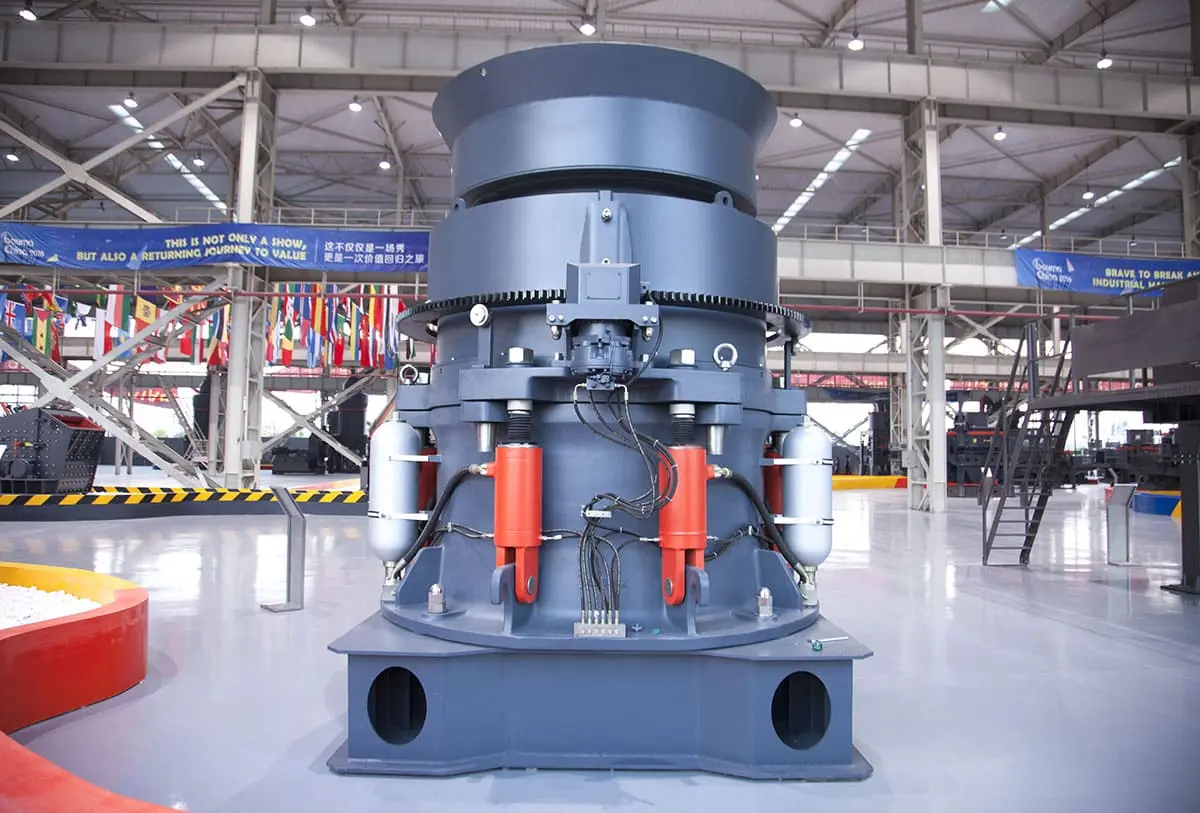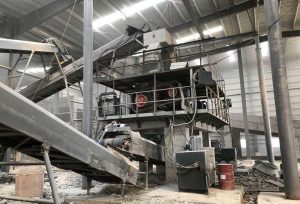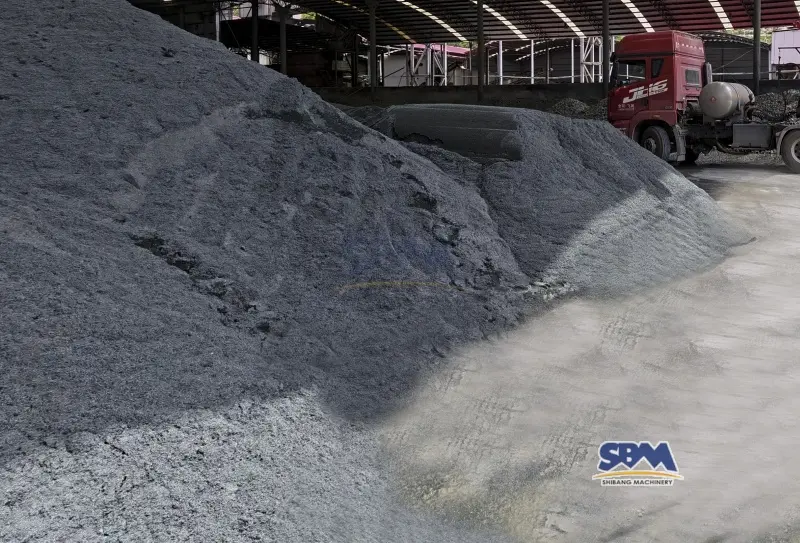Email: [email protected]
Quartz vs Granite
If you’re in construction, countertops, or mineral processing, you’ve definitely wrestled with the “quartz vs granite” question. Both are superstars, but they play very different games. Knowing their quirks isn’t just academic – it dictates the entire processing chain, from the jaw crusher chewing through raw rock to the final polished slab or aggregate. Grab a coffee, and let’s break down this geological rivalry. Spoiler: The winner depends entirely on your project needs and processing power!
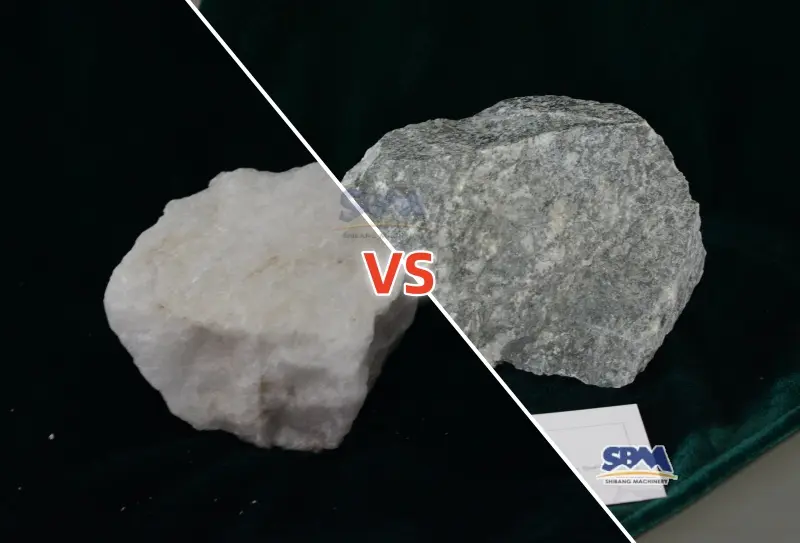
What Are Quartz and Granite?
First things first, let’s clear up some confusion. Quartz, in its pure form, is a single mineral (SiO₂ – silicon dioxide). It’s one of Earth’s hardest common minerals and super abundant. Think sparkling sand grains or massive veins. Granite, however, is a rock – a team player! It’s an igneous rock primarily made of quartz plus feldspar and mica. That team composition gives granite its signature speckled look and varied properties. So, comparing “quartz vs granite” is often comparing the mineral quartz to the rock granite, especially in countertop contexts where “quartz” usually means engineered quartz (resin + crushed quartz). Got it? Good! This fundamental difference drives everything else.
Comparison of Key Properties of Quartz vs Granite
Choosing between quartz and granite? Their inherent properties are your roadmap. Let’s get technical (but keep it painless!):
1. Hardness (Mohs Scale)
- Pure Quartz Mineral: A champ at Mohs 7. Seriously tough! It scratches glass easily.
- Granite Rock: Variable, but generally Mohs 6-7. Why? It contains quartz (hard) but also softer feldspar (Mohs 6) and mica (Mohs 2-3). The quartz grains dominate the scratch resistance.
- Processing Impact: Harder quartz needs robust crushers and grinders. Granite can be slightly less demanding initially, but its abrasiveness due to quartz content is a major wear factor.
2. Porosity & Absorption
- Pure Quartz: Very low porosity. Water struggles to penetrate.
- Granite: Naturally porous, varying by type. Needs sealing, especially for countertops.
- Engineered Quartz: Near-zero porosity (thanks to the resin binder). Super stain-resistant!
- Processing Impact: Porosity affects drying needs in aggregate processing. For slabs, it dictates sealing requirements post-polishing.
3. Chemical Resistance
- Pure Quartz: Highly resistant to acids and chemicals.
- Granite: Feldspar content makes it vulnerable to strong acids (like vinegar, lemon juice, cleaners) – etching occurs.
- Engineered Quartz: Excellent chemical resistance (resin shield!).
- Processing Impact: Chemical resistance is crucial for end-use (countertops) but less so during primary crushing/grinding.
4. Aesthetics & Consistency
- Pure Quartzite (Natural Stone): Often stunningly pure white or translucent, but can have veins. Less common as slabs than granite.
- Granite: Wildly variable colors and patterns (thanks to the mineral mix). Each slab is unique. Love that natural randomness!
- Engineered Quartz: Highly consistent color and pattern (artificial). Huge design flexibility – want metallic flecks? No problem!
- Processing Impact: Natural stone (quartzite/granite) requires careful block selection. Engineered quartz relies on consistent, finely ground quartz powder.
Table 1: Quartz vs Granite – Property Battle Royale
| Property | Pure Quartz (Mineral) | Granite (Rock) | Engineered Quartz (Slab) |
|---|---|---|---|
| Composition | Silicon Dioxide (SiO₂) | Quartz, Feldspar, Mica | Crushed Quartz + Resin |
| Hardness (Mohs) | 7 | 6-7 | 7 (Resin slightly softer) |
| Porosity | Very Low | Porous (Needs Seal) | Non-Porous |
| Acid Resistance | Excellent | Poor (Etches) | Excellent |
| UV Resistance | Excellent | Excellent | Poor (Can Yellow/Fade) |
| Heat Resistance | Excellent | Excellent | Good (Resin Limit ~150°C) |
| Aesthetics | Consistent (Mineral) | Unique, Natural | Highly Consistent |
| Main Use (Slab) | Less Common | Countertops, Tile | Countertops, Vanities |
| Main Use (Aggregate) | High-Purity Sand, Fillers | Construction Aggregate, Road Base | Rare |
From Quarry to Crusher
Let’s dig in! Getting these rocks out of the ground is step one.
- Granite: Mined as huge blocks using drills, explosives (handled safely!), and diamond saws. These blocks weigh tons!
- Quartz: Dug from special mines (or leftover from other mining). High-quality quartz sand might need different digging methods.
Now for the fun part – breaking down these rocks! Meet the primary jaw crusher. This powerful machine smashes large blocks into smaller pieces:
Quartz: Super hard but cracks easier under pressure. Still, it wears down machines fast. Think of this as round one in a rock-smashing contest!
Granite: Though not equally hard all over, its sandpaper-like roughness needs extra-strong crushers with protective liners (manganese steel saves the day!).
The Grinding Grit: Turning Rock into Revenue
After primary crushing, both materials need further downsizing, but their paths diverge based on the final product. Here’s where the “quartz vs granite” processing story gets really interesting!
- Granite Path (Often Aggregate/Construction):
- Secondary Crushing: A cone crusher shapes stones better than another jaw crusher. Warning: Granite’s roughness means checking crusher parts often! Replacing worn bits costs money.
- Tertiary Crushing (Optional): For finer aggregates, an impact crusher might be used to improve cubicity, but be mindful of wear from quartz content.
- Screening: Vibrating screens separate the crushed granite into different aggregate sizes (e.g., 3/4″, 1/2″, crusher run).
- (Less Common Path for Slabs): If producing granite slabs, the quarried blocks go straight to sawing with diamond blades, then polishing – minimal grinding involved compared to quartz production.
- Quartz Path (For Engineered Slabs & High-Purity):
- Secondary & Tertiary Crushing: Achieving a very fine feed for grinding is crucial. Often involves multiple stages (jaw -> cone -> maybe another cone or impact crusher).
- The Star Player: Grinding Mills: Here’s where quartz gets tough! To make powder for countertops (like flour fineness!), vertical roller mills (VRM) or ball mills do the heavy lifting. SBM’s mills (like LUM models) control fineness perfectly – vital for quality slabs. Heads up: Grinding quartz eats lots of power!
- Classification: Air classifiers (like SBM’s high-efficiency classifiers) work with the mills to ensure the powder meets the precise size cut point. Oversize particles get sent back – no slackers allowed!
- Washing & Purification (High-Purity Quartz): For semiconductor or solar grade quartz, quartz gets chemical baths and heat treatment after grinding. Much more complex than regular gravel!
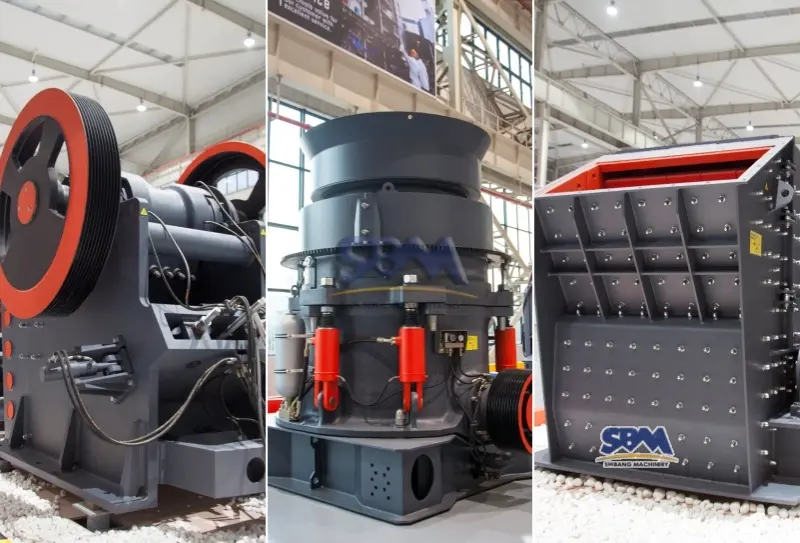
Table 2: Typical Quartz vs Granite Processing Flow (Aggregate Focus)
| Processing Stage | Granite (Aggregate Path) | Quartz (Engineered Slab Feed Path) | Key Machinery Challenges |
|---|---|---|---|
| Primary Crushing | Jaw Crusher (Large Feed Opening) | Jaw Crusher (Robust Design) | Handling large blocks, High abrasiveness (Both) |
| Secondary Crushing | Cone Crusher (for Shape Control) | Cone Crusher / Impact Crusher | Abrasion wear (Granite), Hardness (Quartz) |
| Tertiary Crushing | Cone Crusher / Impact Crusher | Often Required for Quartz | Achieving finer feed for grinding (Quartz) |
| Grinding | Not typical for standard aggregate | Vertical Roller Mill / Ball Mill | High energy consumption (Quartz Hardness), Precise fineness control, Wear on grinding elements |
| Classification | Vibrating Screens (Size Fractions) | Air Classifiers | High efficiency separation critical for fines |
| Final Product | Construction Aggregates (Gravel) | Fine Quartz Powder (Flour) |
Beyond the Crusher: Wear, Tear, and Winning the Maintenance Game
Let’s be real: Processing quartz and granite is tough on kit. That quartz mineral is a beast! Abrasion is enemy number one. For granite, while slightly less hard overall than pure quartz, its quartz content ensures it remains highly abrasive. For pure quartz processing, it’s hardness and abrasiveness. This means:
- Crusher Liners (Jaw, Cone):
- Check and replace often.
- Basic manganese steel works, but for heavy quartz feeds, try stronger metals or ceramic mixes.
- Quick-change systems save time – they’re priceless!
- Grinding Mill Wear Parts (VRM/Ball Mill):
- Rollers, grinding tables, and liners get worn down fast with quartz.
- Use protective coatings, pick the toughest materials, and plan maintenance wisely.
- SBM tip: Our vertical mills have easy-swap parts built to last.
- Conveyors & Chutes:
- Gritty dust is everywhere.
- Add protective liners (like ultra-tough plastic or ceramic tiles) in high-wear spots.
- Seal gaps to keep dust contained – safety always comes first!
What are quartz vs granite used for?
So, after all that crushing and grinding, where do these rocks end up? Their strengths dictate their destinies!
- Granite’s Top Uses:
- Countertops & Tile: Natural beauty wins hearts. Needs yearly sealing.
- Monuments & Dimension Stone: Lasts forever, polishes beautifully.
- Construction Aggregate: The #1 use! Perfect for concrete, roads, and drainage.
- Landscaping: Decorative gravel, boulders.
- Quartz’s Key Roles:
- Engineered Quartz Slabs: #1 choice for modern kitchens. No sealing needed! Made from ultra-fine quartz powder.
- High-Purity Applications: Pure quartz for solar panels and computer chips (needs special cleaning).
- Industrial Sands: For metal casting, sandpaper, and pool filters.
- Fillers: Boosts strength in paints, plastics, and glue (made in SBM mills).
Quartz vs Granite for Countertops: The Homeowner’s Dilemma
Okay, let’s address the kitchen elephant in the room! This is where most folks first encounter the “quartz vs granite” debate.
- Granite Countertops:
- Pros: 100% natural beauty, unique patterns, excellent heat resistance, adds real estate value, very hard surface.
- Cons: Requires periodic sealing (or risks stains), can etch with acids, seams more visible, limited color consistency within a slab, very heavy (needs strong cabinets).
- Engineered Quartz Countertops:
- Pros: Non-porous (no sealing needed!), highly stain and acid resistant, extremely consistent color/pattern, wide range of designs (mimics stone or modern looks), seamless appearance, hygienic.
- Cons: Can be damaged by very high heat (trivets are essential!), higher price point than some granites, potential for UV fading (near windows), less “natural” look for purists.
How to Choose Quartz or Granite?
- Choose Granite If: You adore unique natural stone, prioritize heat resistance, are okay with periodic maintenance (sealing), and want a classic look. Or, if you need high-quality construction aggregate!
- Choose Engineered Quartz If: You want ultra-low maintenance (no sealing!), demand superior stain/acid resistance, desire design consistency and flexibility, and prioritize a hygienic surface. Or, if you’re grinding high-purity sand!
The Future of Rock: Sustainability & Innovation
The “quartz vs granite” story isn’t static. Sustainability is huge! Efficient crushers and grinders (like SBM’s energy-optimized designs) reduce power consumption. Water recycling in processing plants is critical. Engineered quartz often uses recycled materials. Innovation focuses on tougher wear parts, smarter automation, and finding value in “waste” fines (like turning crusher dust into manufactured sand or filler material). The goal? More product, less impact.
Partners in the Mineral World
Quartz vs granite aren’t truly rivals; they’re partners shaping our built world. Understanding their “quartz vs granite” differences – from atomic structure to the massive jaw crusher chewing through a block – is power. It powers smarter material selection for architects and homeowners. Crucially, it drives the design of better, tougher, more efficient crushing and grinding machinery for us manufacturers. Whether you’re processing granite for a new highway or grinding quartz to perfection for a sleek kitchen countertop, having the right equipment (like robust SBM crushers and precision SBM grinding mills) makes all the difference. Choose wisely, process efficiently, and build something amazing! Got rock challenges? We build the solutions.
Headquaters Office
Whatsapp:+8615225176731
Email: [email protected]
Address: No. 1688, Gaoke East Road, Pudong new district, Shanghai, China.
Website: https://www.mill-sbm.com/


